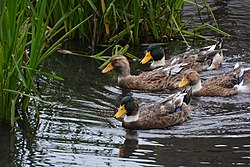Blekinge duck
 From Wikipedia - Reading time: 3 min
From Wikipedia - Reading time: 3 min
 A small flock of Blekinge ducks | |
| Conservation status | Critical (FAO, 2007)[1] |
|---|---|
| Other names | Coast duck |
| Country of origin | Sweden |
| Distribution | Scania |
| Traits | |
| Weight |
|
| Egg color | white[2] |
| Classification | |
| |
The Blekinge duck (Swedish: Blekingeanka), also known as the Coast Duck,[3] is a medium-sized Swedish breed of domestic duck prominent to the county of Blekinge.[4][5]
History
[edit]The breed was first discovered in 1994 where a small flock of 2 drakes and 5 ducks lived with a fishing family in the Blekinge archipelago, hence it is speculated that it was not a duck purposely bred for use in agriculture.[6]
Description
[edit]The Blekinge duck is often a lighter wild-colored duck similar to that of the Mallard, fully white individuals are rare but ever so often seen. The females weigh 2–2.5 kg (4.4–5.5 lb) and the males 2.5–3.5 kg (5.5–7.7 lb).[2]
Females can lay 70–100 white-colored eggs a year with an average weight for the eggs being 70–80 grams and the female can expect to lay on the eggs for 28 days before they hatch.[6][7]
Status
[edit]It is classified as an endangered breed due to its small population by organizations such as the FAO in 2007.[1] In 2012 the breed's population was at its largest with 208 breeding individuals, as of 2021 the breeding population had reduced to a total of 191 individuals but is increasing.[8]
References
[edit]- ^ a b "List of breeds documented in the Global Databank for Animal Genetic Resources" (PDF). www.fao.org. Food and Agriculture Organization of the United Nations. 2007. Archived (PDF) from the original on 2020-06-23. Retrieved 2023-11-08.
- ^ a b "Blekinge duck – Poultry Breeds Encyclopedia". zooenc.eu. Retrieved 2023-11-09.
- ^ "Coast Ducks". feathersite.com. Retrieved 2023-11-08.
- ^ "Blekinge duck". nordensark.se. Archived from the original on 2014-12-26. Retrieved 2023-11-08.
- ^ "Blekingeanka". nordensark.se (in Swedish). Archived from the original on 2016-01-24. Retrieved 2023-11-08.
- ^ a b "Blekingeanka". hagetslantrasgard.se (in Swedish). Retrieved 2023-11-08.
- ^ "Blekingeanka". smakasverige.jordbruksverket.se (in Swedish). 2018-07-05. Archived from the original on 22 September 2020. Retrieved 2023-11-08.
- ^ "Breed data sheet: Blekingeanka / Sweden (Duck (domestic))". Domestic Animal Diversity Information System of the Food and Agriculture Organization of the United Nations. 2021. Retrieved 2023-11-17.
 KSF
KSF